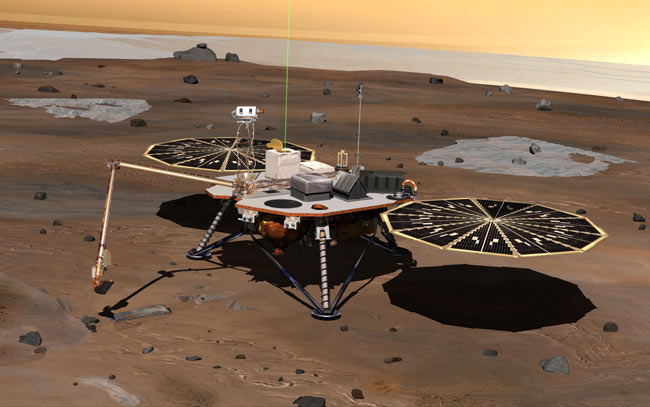NASA Spacecraft Set to Study Mars' Icy North Pole

Preparations are on track for the launch of a new NASA Mars lander early next month to search for subsurface water and potential life in the red planet’s arctic northern region.
Gearing up of the space agency’s Phoenix Mars mission comes as another mission stands down due to weather concerns. The launch of Dawn, a mission to explore two rocky objects in the solar system’s Asteroid Belt, has been pushed back to no earlier than September, at an additional estimated cost of $20 to $25 million.
If Phoenix launches as planned on Aug. 3, it will reach Mars on May 25, 2008. Once it reaches its target, the spacecraft will barrel directly into the Martian atmosphere and attempt the first soft-landing on the red planet since the NASA's Viking missions more than 30 years ago.
Phoenix will use a heat shield and parachute to slow its high-speed entry, and pulsed descent rockets to lower it down safely.
“Entry, descent and landing is a challenge no matter what mission you’re flying,” said Doug McCuistion, NASA’s Mars Exploration Program manager. “Mars has a tendency to throw you curveballs that are somewhat unexpected.”
Of all the attempts to land spacecraft on Mars, less than half have been successful.
A second chance
Phoenix is the first spacecraft of NASA’s Mars Scout Program, designed to explore the red planet using small, low-cost robots. “They’re smaller, less expensive … and tend to be a little more adventurous than the strategic missions; a little higher risk with a potentially higher payoff,” McCuistion said.
Breaking space news, the latest updates on rocket launches, skywatching events and more!
The total cost of the mission is estimated to be about $420 million. As its name implies, Phoenix is NASA’s second attempt to explore the Martian polar regions after the Mars Polar Lander was lost in 1999. It will carry many of the same instruments as that ill-fated spacecraft, as well as instruments recycled from the canceled Mars Surveyor 2001 Lander.
Phoenix carries a robotic arm that can extend up to eight feet (2.4 meters) and is capable of digging down to a depth of three feet (0.9 meters) into the red planet’s permafrost in search of ice. “Phoenix has been designed to examine the history of the ice by measuring how liquid water has modified the chemistry and mineralogy of the soil,” said Peter Smith, the Phoenix principal investigator at the University of Arizona.
It is also equipped with instruments to analyze the chemistry of the soil and detect complex organic molecules, a stereo camera to survey the landing site and a laser that will shoot a beam of green light into the Martian sky to monitor weather conditions.
Digging in
The spacecraft will land on Mar’s unexplored northern polar region. The landing site is located around 70 degrees north latitude. On Earth, this is equivalent to northern parts of Alaska, Greenland and Siberia. Scientists predict that up to 58 percent of the Martian subsurface at the planet’s poles is water ice.
“Phoenix will land in the northern plains, touch down and dig down into the subsurface to actually touch this water,” said Phoenix program scientist Bobby Fogel. “It’s going to get its chemical composition, its physical properties, and try to tell us something about the history of water on Mars and the potential habitability of microbes on Mars.”
The mission is officially set to last three months, but could be extended if the lander manages to survive the harsh Martian winter.
“I’d be thrilled to actually see the ice starting to form in the winter,” Smith said. “We’re hopeful that we can survive long enough to see ice, but it’s probably unlikely.”
- All About Phoenix Mars Lander
- VIDEO: Unfinished Business - Mars Rover Team Ponders Mission's End
- Phoenix Mars Lander Prepared to Weather Dust Storms
Ker Than is a science writer and children's book author who joined Space.com as a Staff Writer from 2005 to 2007. Ker covered astronomy and human spaceflight while at Space.com, including space shuttle launches, and has authored three science books for kids about earthquakes, stars and black holes. Ker's work has also appeared in National Geographic, Nature News, New Scientist and Sky & Telescope, among others. He earned a bachelor's degree in biology from UC Irvine and a master's degree in science journalism from New York University. Ker is currently the Director of Science Communications at Stanford University.
